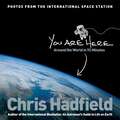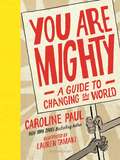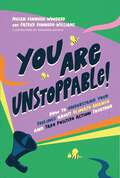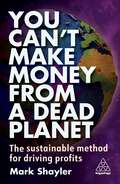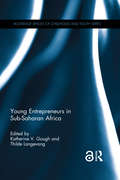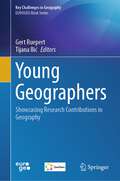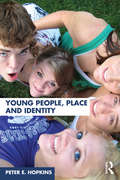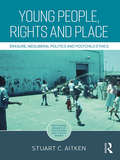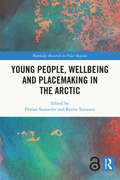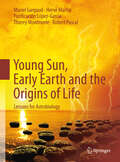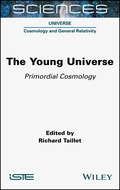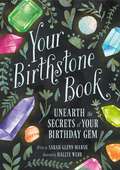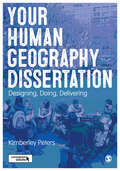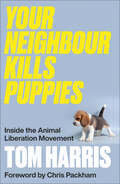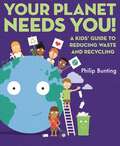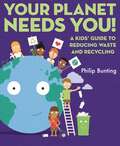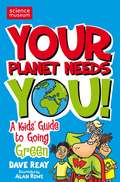- Table View
- List View
You Are Here: Around the World in 92 Minutes
by Chris HadfieldIn You Are Here, celebrated astronaut Chris Hadfield gives us the really big picture: this is our home, as seen from space. The millions of us who followed Hadfield's news-making Twitter feed from the International Space Station thought we knew what we were looking at when we first saw his photos. But we may have caught the beauty and missed the full meaning. Now, through photographs – many of which have never been shared – Hadfield unveils a fresh and insightful look at our planet. He sees astonishing detail and importance in these images, not just because he's spent months in space but because his in-depth knowledge of geology, geography and meteorology allows him to reveal the photos' mysteries.Featuring Hadfield's favourite images, You Are Here is divided by continent and represents one (idealized) orbit of the ISS. Surprising, thought-provoking and visually delightful, it opens a singular window on our planet, using remarkable photographs to illuminate the history and consequences of human settlement, the magnificence of never-before-noticed landscapes, and the power of the natural forces shaping our world and the future of our species.
You Are Mighty: A Guide to Changing the World
by Caroline Paul Lauren TamakiBeing a good citizen means standing up for what's right-and here's just the way to start. From the author of The Gutsy Girl, this kids' guide to activism is the perfect book for those with a fierce sense of justice, a good sense of humor, and a big heart. This guide features change-maker tips, tons of DIY activities, and stories about the kids who have paved the way before, from famous activists like Malala Yousafzai and Claudette Colvin to the everyday young people whose habit changes triggered huge ripple effects. So make a sign, write a letter, volunteer, sit-in, or march! There are lots of tactics to choose from, and you're never too young to change the world.
You Are Unstoppable!: How to Understand Your Feelings about Climate Change and Take Positive Action Together
by Megan Kennedy-Woodard Dr. Patrick Kennedy-WilliamsFeeling sad, scared or angry about climate change? You are not alone. It means that you care. This book helps you harness the power of these emotions and turn them into climate action that will leave you feeling connected, motivated, and powerfully optimistic.You will learn how to:· notice and manage your eco-emotions· become a self-care champion· turn climate anxiety into climate action· inspire others to make changes· and most importantly, enjoy the climate work you do!Your journey starts today. You are unstoppable!"
You Are Unstoppable!: How to Understand Your Feelings about Climate Change and Take Positive Action Together
by Megan Kennedy-Woodard Dr. Patrick Kennedy-WilliamsFeeling sad, scared or angry about climate change? You are not alone. It means that you care. This book helps you harness the power of these emotions and turn them into climate action that will leave you feeling connected, motivated, and powerfully optimistic.You will learn how to:· notice and manage your eco-emotions· become a self-care champion· turn climate anxiety into climate action· inspire others to make changes· and most importantly, enjoy the climate work you do!Your journey starts today. You are unstoppable!"
You Can’t Make Money From a Dead Planet: The Sustainable Method for Driving Profits
by Mark ShaylerDoing good is no longer a luxury or a 'nice to have', it's a necessity.While businesses, both big and small, have undoubtedly caused the majority of our environmental and sustainability problems, only they can solve these issues at scale. You Can't Make Money from a Dead Planet looks at the challenges we face and shows how business needs to change in order to be the driver of the solution. Bestselling author and sustainability strategist Mark Shayler explains why there is no contradiction between being profitable and doing the right thing for the planet and doing the right thing for your customers. Providing the insights, the enthusiasm and the tools to align your business with sustainability, it blends explanations of the challenges that we face, with stories from those business that have excelled in sustainability. Exploring current sustainability approaches and trends including net-zero, circular economy, ESG, B-Corps, zero waste and environmental management systems, You Can't Make Money From a Dead Planet explains, debunks and helps you navigate the sustainable agenda while growing your business.
You Can’t Make Money From a Dead Planet: The Sustainable Method for Driving Profits
by Mark ShaylerDoing good is no longer a luxury or a 'nice to have', it's a necessity.While businesses, both big and small, have undoubtedly caused the majority of our environmental and sustainability problems, only they can solve these issues at scale. You Can't Make Money from a Dead Planet looks at the challenges we face and shows how business needs to change in order to be the driver of the solution. Bestselling author and sustainability strategist Mark Shayler explains why there is no contradiction between being profitable and doing the right thing for the planet and doing the right thing for your customers. Providing the insights, the enthusiasm and the tools to align your business with sustainability, it blends explanations of the challenges that we face, with stories from those business that have excelled in sustainability. Exploring current sustainability approaches and trends including net-zero, circular economy, ESG, B-Corps, zero waste and environmental management systems, You Can't Make Money From a Dead Planet explains, debunks and helps you navigate the sustainable agenda while growing your business.
Young Entrepreneurs in Sub-Saharan Africa (Routledge Spaces of Childhood and Youth Series)
by Katherine V. Gough Thilde LangevangYoung people in sub-Saharan Africa are growing up in rapidly changing social and economic environments which produce high levels of un- and underemployment. Job creation through entrepreneurship is currently being promoted by international organizations, governments and NGOs as a key solution, despite there being a dearth of knowledge about youth entrepreneurship in an African context. This book makes an important contribution by exploring the nature of youth entrepreneurship in Ghana, Uganda and Zambia. It provides new insights into conceptual and methodological discussions of youth entrepreneurship as well as presenting original empirical data. Drawing on quantitative and qualitative research, conducted under the auspices of a collaborative, interdisciplinary and comparative research project, it highlights the opportunities and challenges young people face in setting up and running businesses. Divided into a number of clear sections, each with its own introduction and conclusion, the book considers the nature of youth entrepreneurship at the national level, in both urban and rural areas, in specific sectors - including mobile telephony, mining, handicrafts and tourism - and analyses how key factors, such as microfinance, social capital and entrepreneurship education, affect youth entrepreneurship. New light is shed on the multi-faceted nature of youth entrepreneurship and a convincing case is presented for a more nuanced understanding of the term entrepreneurship and the situation faced by many African youth today. This book will be of interest to a wide range of scholars interested in youth entrepreneurship, including in development studies, business studies, youth studies and geography, as well as to development practitioners and policy makers. The Open Access title has now been added to the Open Access page. http://www.tandfebooks.com/page/openaccess
Young Entrepreneurs in Sub-Saharan Africa (Routledge Spaces of Childhood and Youth Series)
by Katherine V. Gough Thilde LangevangYoung people in sub-Saharan Africa are growing up in rapidly changing social and economic environments which produce high levels of un- and underemployment. Job creation through entrepreneurship is currently being promoted by international organizations, governments and NGOs as a key solution, despite there being a dearth of knowledge about youth entrepreneurship in an African context. This book makes an important contribution by exploring the nature of youth entrepreneurship in Ghana, Uganda and Zambia. It provides new insights into conceptual and methodological discussions of youth entrepreneurship as well as presenting original empirical data. Drawing on quantitative and qualitative research, conducted under the auspices of a collaborative, interdisciplinary and comparative research project, it highlights the opportunities and challenges young people face in setting up and running businesses. Divided into a number of clear sections, each with its own introduction and conclusion, the book considers the nature of youth entrepreneurship at the national level, in both urban and rural areas, in specific sectors - including mobile telephony, mining, handicrafts and tourism - and analyses how key factors, such as microfinance, social capital and entrepreneurship education, affect youth entrepreneurship. New light is shed on the multi-faceted nature of youth entrepreneurship and a convincing case is presented for a more nuanced understanding of the term entrepreneurship and the situation faced by many African youth today. This book will be of interest to a wide range of scholars interested in youth entrepreneurship, including in development studies, business studies, youth studies and geography, as well as to development practitioners and policy makers. The Open Access title has now been added to the Open Access page. http://www.tandfebooks.com/page/openaccess
Young Geographers: Showcasing Research Contributions in Geography (Key Challenges in Geography)
by Gert Ruepert Tijana IlićThis book shows an updated overview of research about human geography topics like urban growth/urban challenges, transportation, landscape, land cover, geospatial analysis, regional planning/local development, cultural geography, tourism, and so on. Between 2020 and 2022, due to COVID-19 and lockdowns worldwide, there were fewer opportunities for young and upcoming researchers to present their state-of-the-art findings at conferences. In order to highlight exceptional research of young geographers during this time, the idea for this book was created. In collaboration with the EGEA alumni foundation for students and young geographers, 12 authors were selected to showcase their scientific work. In addition to that, most of them present amazing maps and figures as outstanding expression of the need of GIS for geography research.
Young People, Place and Identity
by Peter E. HopkinsYoung People, Place and Identity offers a series of rich insights into young people’s everyday lives. What places do young people engage with on a daily basis? How do they use these places? How do their identities influence these contexts? By working through common-sense understandings of young people’s behaviours and the places they occupy, the author seeks to answer these and other questions. In doing so the book challenges and re-shapes understandings of young people’s relationships with different places and identities. The textbook is one of the first books to map out the scales, themes and sites engaged with by young people on a daily basis as they construct their multiple identities. The scales explored here include the body, neighbourhood and community, mobilities and transitions and urban-rural settings and how these all shape and are shaped by young people’s identities. Each chapter explores how social identities (such as race, gender, sexuality, class, disability and religion) are constructed within particular contexts and influenced by multiple processes of inclusion and exclusion. These discussions are supported by details of the research methods and ethical issues involved in researching young people’s lives. Drawing upon research from a range of contexts, including Europe, North America and Australasia, this book demonstrates the complex ways in which young people creatively shape, contest and resist their engagements with different places and identities. The range of issues, topics and case studies explored include: ethical and methodological issues in youth research; youth subcultures; experiences of home; territorialism; youth and crime; political engagement and participation; responses to global issues; engagements with different institutional contexts; negotiating public space; the transition to adulthood; drinking cultures. The author explores these issues through blending together original empirical research, theory and policy. Individual chapters are supported by key themes, project ideas and suggested further reading. Details of key authors, journals and research centres and organisations are also included at the end of the book. This textbook will be pertinent for undergraduate and postgraduate students and academic researchers interested in better understanding the relationships between young people, places and identities.
Young People, Place and Identity
by Peter E. HopkinsYoung People, Place and Identity offers a series of rich insights into young people’s everyday lives. What places do young people engage with on a daily basis? How do they use these places? How do their identities influence these contexts? By working through common-sense understandings of young people’s behaviours and the places they occupy, the author seeks to answer these and other questions. In doing so the book challenges and re-shapes understandings of young people’s relationships with different places and identities. The textbook is one of the first books to map out the scales, themes and sites engaged with by young people on a daily basis as they construct their multiple identities. The scales explored here include the body, neighbourhood and community, mobilities and transitions and urban-rural settings and how these all shape and are shaped by young people’s identities. Each chapter explores how social identities (such as race, gender, sexuality, class, disability and religion) are constructed within particular contexts and influenced by multiple processes of inclusion and exclusion. These discussions are supported by details of the research methods and ethical issues involved in researching young people’s lives. Drawing upon research from a range of contexts, including Europe, North America and Australasia, this book demonstrates the complex ways in which young people creatively shape, contest and resist their engagements with different places and identities. The range of issues, topics and case studies explored include: ethical and methodological issues in youth research; youth subcultures; experiences of home; territorialism; youth and crime; political engagement and participation; responses to global issues; engagements with different institutional contexts; negotiating public space; the transition to adulthood; drinking cultures. The author explores these issues through blending together original empirical research, theory and policy. Individual chapters are supported by key themes, project ideas and suggested further reading. Details of key authors, journals and research centres and organisations are also included at the end of the book. This textbook will be pertinent for undergraduate and postgraduate students and academic researchers interested in better understanding the relationships between young people, places and identities.
Young People, Rights and Place: Erasure, Neoliberal Politics and Postchild Ethics (Routledge Spaces of Childhood and Youth Series)
by Stuart C. AitkenConcern is growing about children’s rights and the curtailment of those rights through the excesses of neoliberal governance. This book discusses children’s spatial and citizenship rights, and the ways young people and their families push against diminished rights. Armed initially with theoretical concerns about the construction of children through the political status quo and the ways youth rights are spatially segregated, the book begins with a disarmingly simple supposition: Young people have the right to make and remake their spaces and, as a consequence, themselves. This book de-centers monadic ideas of children in favor of a post-humanist perspective, which embraces the radical relationality of children as more-than-children/more-than-human. Its empirical focus begins with the struggles of Slovenian Izbrisani (‘erased’) youth from 1992 to the present day and reaches out to child rights and youth activists elsewhere in the world with examples from South America, Eastern Europe and the USA. The author argues that universal child rights have not worked and pushes for a more radical, sustainable ethics, which dares to admit that children’s humanity is something more than we, as adults, can imagine. Chapters in this groundbreaking contribution will be of interest to students, researchers and practitioners in the social sciences, humanities and public policy.
Young People, Rights and Place: Erasure, Neoliberal Politics and Postchild Ethics (Routledge Spaces of Childhood and Youth Series)
by Stuart C. AitkenConcern is growing about children’s rights and the curtailment of those rights through the excesses of neoliberal governance. This book discusses children’s spatial and citizenship rights, and the ways young people and their families push against diminished rights. Armed initially with theoretical concerns about the construction of children through the political status quo and the ways youth rights are spatially segregated, the book begins with a disarmingly simple supposition: Young people have the right to make and remake their spaces and, as a consequence, themselves. This book de-centers monadic ideas of children in favor of a post-humanist perspective, which embraces the radical relationality of children as more-than-children/more-than-human. Its empirical focus begins with the struggles of Slovenian Izbrisani (‘erased’) youth from 1992 to the present day and reaches out to child rights and youth activists elsewhere in the world with examples from South America, Eastern Europe and the USA. The author argues that universal child rights have not worked and pushes for a more radical, sustainable ethics, which dares to admit that children’s humanity is something more than we, as adults, can imagine. Chapters in this groundbreaking contribution will be of interest to students, researchers and practitioners in the social sciences, humanities and public policy.
Young People, Wellbeing and Sustainable Arctic Communities (Routledge Research in Polar Regions)
by Stammler Florian Toivanen ReettaYouth are usually not (yet) decision makers in politics or in business corporations, but the sustainability of Arctic settlements depends on whether or not youth envision such places as offering opportunities for a good future. This is the first multidisciplinary volume presenting original research on Arctic youth. This edited book presents the results of two research projects on youth wellbeing and senses of place in the Arctic region. The contributions are united by their focus on agency. Rather than seeing youth as vulnerable and possible victims of decisions by others, they illustrate the diverse avenues that youth pursue to achieve a good life in the Arctic. The contributions also show which social, economic, political and legal conditions provide the best frame for youth agency in Arctic settlements. Rather than portraying the Arctic as a resource frontier, a hotspot for climate change and a place where biodiversity and traditional Indigenous cultures are under threat, the book introduces the Arctic as a place for opportunities, the realization of life trajectories and young people’s images of home. Rooted in anthropology, the chapters also feature contributions from the fields of sociology, geography, sustainability science, legal studies and political science. This book is intended for an audience interested in anthropology, political science, Arctic urban studies, youth studies, Arctic social sciences and humanities in general. It would attract those working on Arctic sustainability, wellbeing in the Arctic, Arctic demography and overall wellbeing of youth.
Young People, Wellbeing and Sustainable Arctic Communities (Routledge Research in Polar Regions)
by Florian Stammler Reetta ToivanenYouth are usually not (yet) decision makers in politics or in business corporations, but the sustainability of Arctic settlements depends on whether or not youth envision such places as offering opportunities for a good future. This is the first multidisciplinary volume presenting original research on Arctic youth. This edited book presents the results of two research projects on youth wellbeing and senses of place in the Arctic region. The contributions are united by their focus on agency. Rather than seeing youth as vulnerable and possible victims of decisions by others, they illustrate the diverse avenues that youth pursue to achieve a good life in the Arctic. The contributions also show which social, economic, political and legal conditions provide the best frame for youth agency in Arctic settlements. Rather than portraying the Arctic as a resource frontier, a hotspot for climate change and a place where biodiversity and traditional Indigenous cultures are under threat, the book introduces the Arctic as a place for opportunities, the realization of life trajectories and young people’s images of home. Rooted in anthropology, the chapters also feature contributions from the fields of sociology, geography, sustainability science, legal studies and political science. This book is intended for an audience interested in anthropology, political science, Arctic urban studies, youth studies, Arctic social sciences and humanities in general. It would attract those working on Arctic sustainability, wellbeing in the Arctic, Arctic demography and overall wellbeing of youth.
Young Sun, Early Earth and the Origins of Life: Lessons for Astrobiology
by Muriel Gargaud Hervé Martin Purificación López-García Thierry Montmerle Robert Pascal- How did the Sun come into existence? - How was the Earth formed? - How long has Earth been the way it is now, with its combination of oceans and continents? - How do you define “life”? - How did the first life forms emerge? - What conditions made it possible for living things to evolve? All these questions are answered in this colourful textbook addressing undergraduate students in "Origins of Life" courses and the scientifically interested public. The authors take the reader on an amazing voyage through time, beginning five thousand million years ago in a cloud of interstellar dust and ending five hundred million years ago, when the living world that we see today was finally formed. A chapter on exoplanets provides an overview of the search for planets outside the solar system, especially for habitable ones.The appendix closes the book with a glossary, a bibliography of further readings and a summary of the Origins of the Earth and life in fourteen boxes.
The Young Universe: Primordial Cosmology
by Richard TailletThe Young Universe presents four major physical and astrophysical themes related to these extreme phases of the primordial universe. In particular, it presents the physics of the primordial plasma and the concepts of quantum and particle physics necessary to describe this extreme state.It discusses the cosmological background radiation and explores inflation, an extremely rapid expansion phase that is believed to have occurred very early in cosmological history and to have shaped our present universe. The book also provides a synthesis of the dark matter problem.
The Young Universe: Primordial Cosmology
by Richard TailletThe Young Universe presents four major physical and astrophysical themes related to these extreme phases of the primordial universe. In particular, it presents the physics of the primordial plasma and the concepts of quantum and particle physics necessary to describe this extreme state.It discusses the cosmological background radiation and explores inflation, an extremely rapid expansion phase that is believed to have occurred very early in cosmological history and to have shaped our present universe. The book also provides a synthesis of the dark matter problem.
Your Birthstone Book: Unearth the Secrets of Your Birthday Gem
by Sarah Glenn MarshLearn the amazing (and sometimes magical) history of gemstones from around the world through the corresponding birthstones that represent each month of the year.Gemstones are among Earth&’s rarest and most beautiful creations. They are history&’s preeminent symbols of wealth and power. They are valued because they are beautiful and rare, but also because their beauty is undiminished with time. The stone that once adorned a king or maharaja, might today be set in a ring or necklace, and if not destroyed, will continue to sparkle thousands of years from now. This history only increases the value of these stones.What better way to teach young readers about gemstones than by focusing on the different birthstones that correspond to each month of the year? Everyone (mostly) knows their birthstone. But do they know the full history of these stones--where they were mined, how/why they were popular, or how to best harness a stone's energy to help deal with matters of friendship, family, and life? Your Birthstone Book will give readers insight into the powers assigned different bithstones while exploring their fascinating uses over the course of history.
Your Human Geography Dissertation: Designing, Doing, Delivering (1st edition) (PDF)
by Kimberley PetersAn undergraduate dissertation is your opportunity to engage with geographical research, first-hand. But completing a student project can be a stressful and complex process. Your Human Geography Dissertation breaks the task down into three helpful stages: Designing: Deciding on your approach, your topic and your research question, and ensuring your project is feasible Doing: Situating your research and selecting the best methods for your dissertation project Delivering: Dealing with data and writing up your findings With information and task boxes, soundbites offering student insight and guidance, and links to online materials, this book offers a complete and accessible overview of the key skills needed to prepare, research, and write a successful human geography dissertation.
Your Human Geography Dissertation: Designing, Doing, Delivering (1st edition)
by Kimberley PetersAn undergraduate dissertation is your opportunity to engage with geographical research, first-hand. But completing a student project can be a stressful and complex process. Your Human Geography Dissertation breaks the task down into three helpful stages: Designing: Deciding on your approach, your topic and your research question, and ensuring your project is feasible Doing: Situating your research and selecting the best methods for your dissertation project Delivering: Dealing with data and writing up your findings With information and task boxes, soundbites offering student insight and guidance, and links to online materials, this book offers a complete and accessible overview of the key skills needed to prepare, research, and write a successful human geography dissertation.
Your Neighbour Kills Puppies: Inside the Animal Liberation Movement
by Tom Harris‘Harris reveals the history of an extraordinary animal rights campaign that I was proud to be associated with. A heartfelt and important account of a movement that inspired thousands’ Benjamin Zephaniah, poet and activist‘When DIY ethos plays out on a grand scale, it has the power to shake governments and change the world. This is a must-read for all contemporary activists’ Moby, musician‘A story of compassion and courage that was crushed by the state, and a powerful testament to the inspirational campaigns of people who stood for a world without suffering’ Peter Tatchell, campaigner for human and animal liberationFor many people, the name ‘Huntingdon Life Sciences’ will live forever in infamy. In the early 2000s, Europe’s largest animal testing laboratory provoked public outrage, and sparked a resistance movement like no other. Your Neighbour Kills Puppies tells the inside story of this remarkable campaign and the forces that rose up against it. It exposes a murky world of institutional animal exploitation, government collusion, corporate lobbyists, agent provocateurs and police spies desperate to silence dissent.Author and campaign veteran Tom Harris transports the reader into the heart of the action, through underground tunnels and illicit animal rescues, before detailing the brutal state-led crackdown which saw scores of activists violently arrested and imprisoned.Tom Harris has spent two decades in the animal liberation movement and is a former coordinator of Stop Huntingdon Animal Cruelty. He received a five-year prison sentence during the attempted ‘elimination’ of the anti-vivisection movement and is a named victim in the Miscarriages of Justice category of the Government’s Undercover Policing Inquiry.
Your Planet Needs You: A Kids' Guide to Reducing Waste and Recycling
by Phillip BuntingFor Earth Day and all year round, an inspiring guide that teaches young activists how to combat waste.Each year, a single person can create up to a ton of garbage. That's the weight of a small hippo! Where does all that waste come from? Where does it end up? How does composting work? And what else can we do to help our planet? Your Planet Needs You! is packed with simple explanations of of how kids and their families can reduce, re-use, and recycle to help clean up our planet.With easy-to-read infographics and a light, accessible tone, Your Planet Needs You! shows that taking care of our environment can be both fun and rewarding.
Your Planet Needs You: A Kids' Guide to Reducing Waste and Recycling
by Phillip BuntingFor Earth Day and all year round, an inspiring guide that teaches young activists how to combat waste.Each year, a single person can create up to a ton of garbage. That's the weight of a small hippo! Where does all that waste come from? Where does it end up? How does composting work? And what else can we do to help our planet? Your Planet Needs You! is packed with simple explanations of of how kids and their families can reduce, re-use, and recycle to help clean up our planet.With easy-to-read infographics and a light, accessible tone, Your Planet Needs You! shows that taking care of our environment can be both fun and rewarding.
Your Planet Needs You!: A Kid's Guide to Going Green
by Dave ReayMaximus, Saviour of Worlds, Protector of Humankind and Chocolate Fanatic, has been give a mission by the President of the Earth: stop the planet from heating up, and do it fast! Join Max and his friend Henry as they become Global Warming Warriors, taking on the Big Climate Culprits one by one. They'll give you some top tips for energy conservation - at home, in the garden, at school... from recycling to compost to turning off that switch! This book is full of useful information and advice for eco-friendly kids in training.
